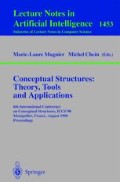Abstract
The paper considers the problem of classifying countable-uncountable entities during the process of Knowledge Acquisition (KA) from texts. Since one of the main goals of KA is to identify types, means to distinguish new types, instances and individuals become particularly important. We review briefly related studies to show that the distinction countable-uncountable depends on the considered natural language, context usage and the domain; then countability is a perspective to look at a closed world since there is no universal general taxonomy. Finally we propose an internal ontological solution for mass objects which suits to a. project for generation of multilingual Natural Language (NL) explanations from Conceptual Graphs (CG).
Preview
Unable to display preview. Download preview PDF.
References
Angelova, G., Boncheva, K.: DB-MAT: Knowledge Acquisition, Processing and NL Generation using Conceptual Graphs. ICCS-96, LNAI 1115 (1997) 115–129.
Angelova, G., Boncheva, K.: Task-Dependent Aspects of Knowledge Acquisition: a Case Study in a Technical Domain. ICCS-97, LNAI 1257 (1996) 183–197.
Dale, R.: Generating Referring Expressions in a Domain of Objects and Processes. Ph.D. Thesis, University of Edinburgh (1988).
Fridman, N., Hafner, C.: The State of the Art in Ontology Design. A Survey and Comparative Review. AI Magazine Vol. 18(3) (1997), 53–74.
Guarino, N.: Some Organizing Principles for a Unified Top-Level Ontology. In: Working Notes AAAI Spring Symp. on Ontological Engineering, Stanford (1997).
Hayes, P.: The Second Naive Physics Manifesto. In Brachman, Levesque (eds.) Readings in Knowledge Representation, Morgan Kaufmann Publ. (1985) 468–485.
Hobbs, J.: Sketch of an ontology underlying the way we talk about the world. Int. J. Human-Computer Studies 43 (1995), 819–830.
Molhova, J. The Noun: a Contrastive English — Bulgarian Study. Publ. House of the Sofia University “St. Kl. Ohridski”, Sofia (1992).
Sowa, J.: Conceptual Structures: Information Processing in Mind and Machine. Addison-Wesley, Reading, MA (1984).
Sowa, J.: Conceptual Graphs Summary. In: Nagle, Nagle, Gerholz, Eklund (Eds.), Cone. Structures: Current Research and Practice, Ellis Horwood (1992) 3–52.
Tepfenhart, W.: Representing Knowledge about Substances. LNAI 754 (1992) 59–71.
Winston, M., Chaffin, R., Herrmann, D.: A Taxonomy of Part-Whole Relations. Cognitive Science 11 (1987) 417–444.
Author information
Authors and Affiliations
Editor information
Rights and permissions
Copyright information
© 1998 Springer-Verlag Berlin Heidelberg
About this paper
Cite this paper
Angelova, G. (1998). Manual acquisition of uncountable types in closed worlds. In: Mugnier, ML., Chein, M. (eds) Conceptual Structures: Theory, Tools and Applications. ICCS 1998. Lecture Notes in Computer Science, vol 1453. Springer, Berlin, Heidelberg. https://doi.org/10.1007/BFb0054926
Download citation
DOI: https://doi.org/10.1007/BFb0054926
Published:
Publisher Name: Springer, Berlin, Heidelberg
Print ISBN: 978-3-540-64791-1
Online ISBN: 978-3-540-68673-6
eBook Packages: Springer Book Archive

